Follow-up
Telegram’s gaming scene faces a hiccup as Catizen and Hamster Kombat delay their token drops
Published
4 months agoon
By
admin

With both Catizen and Hamster Kombat missing their airdrop deadlines, what are the underlying issues causing these delays?
Lately, there’s been a lot of buzz in the Telegram gaming community about two highly anticipated token airdrops: CATI from the puzzle game Catizen and HMSTR from the viral tap-to-earn game (T2E) Hamster Kombat.
Both were set to launch their tokens on The Open Network (TON) in July. As the end of the month approaches, neither has delivered on their promises, causing frustration among eager players.
Catizen’s creators, Pluto Studio, have openly addressed the delay, citing planning challenges.
Similarly, the Hamster Kombat team has hinted through social media that their token release might not happen this month either, despite their website still listing July as the target date.
Let’s understand what has happened and why there are delays.
Why Catizen’s airdrop is on pause
Catizen is a web3 social entertainment platform on Telegram, aiming to create a decentralized app that integrates mini-games, short dramas, and e-commerce.
Catizen boasts over 27 million active users worldwide and has handled more than 20 million on-chain transactions to date.
In addition to this success, Telegram founder Pavel Durov recently mentioned that Catizen earned $16 million from in-game purchases. Impressively, they also donated 1% of this amount to save homeless cats.
The planned airdrop of CATI tokens, which involves distributing 43% of all CATI tokens using the TON blockchain, was eagerly awaited by the Catizen community. However, the giveaway has been postponed.
According to Pluto Studio, the developer behind Catizen, several challenges have arisen during the planning stages. They cited the need to optimize key elements like securing leading exchanges, ensuring sufficient liquidity, and determining the listing price. Compliance and market sentiment have also played a role in this delay.
Dear Catizen Community,
We’ve received many heartfelt inquiries about the progress of our airdrop, as well as concerns regarding recent changes within Catizen. We are confident these changes will benefit Catizen and its players in the long run.
We welcome all feedback and we…
— Catizen (@CatizenAI) July 29, 2024
Pluto Studio also revealed that seed round investors, advisors, and the team will receive 0% of the CATI tokens at the token generation event (TGE). Instead, there will be a 12-month cliff period followed by a 4-year vesting schedule. This strategy is designed to align the interests of the developers and the community, ensuring the long-term value of the CATI token.
The team at Catizen has asked for patience and understanding from their community, promising that they are doing everything possible to deliver the anticipated results.
Besides the delay in launching their token, Pluto Studio has also faced player frustration due to a $100,000 donation they made to the animal rights nonprofit People for the Ethical Treatment of Animals (PETA) earlier this month.
This donation was part of an effort to share a portion of the game’s profits with charities helping stray cats. However, PETA’s controversial history of euthanizing animals that they deem beyond help has caused a backlash.
On July 29, Pluto tweeted that they had ‘received feedback’ about PETA’s practices and had ‘temporarily suspended’ the collaboration. They clarified that all Catizen donations to PETA would be used solely for feeding, vaccination, rescue, and adoption assistance.
Community’s Voices Heard, Feedback Received, Action Taken!
We have received feedback from the community regarding PETA’s past actions of euthanizing animals. In response, we have contacted PETA team and received the following confirmation:
1. PETA has provided an 🔗official…
— Catizen (@CatizenAI) July 29, 2024
Meanwhile, Bybit, the world’s second-largest cryptocurrency exchange by trading volume, has announced that it will list the CATI token on its pre-market trading platform on July 30.
Hamster Kombat’s airdrop delay
Hamster Kombat is a popular game built within the messaging platform Telegram. In Hamster Kombat, players act as the hamster CEO of a fictional crypto exchange, aiming to boost their startup to the top of the industry by investing in marketing, licenses, talent, new products, and more.
In just a few months, Hamster Kombat has amassed over 250 million players, making it a key player in the Telegram gaming community, although it has drawn criticism from government officials along the way.
In May, Hamster Kombat announced via Twitter their decision to launch their token, HMSTR, on the TON blockchain. Their website still indicates a July date for the TGE. However, as July comes to an end, the token has yet to be launched.
Recently, Hamster Kombat addressed the community through another tweet, explaining the situation. They highlighted the complexity of the technical task involved in the airdrop, considering the scale of Hamster Kombat as one of the biggest projects in the industry, which could result in the largest airdrop in history.
Dear CEOs,
We’ve received a lot of comments about the new Playground section, and we want to address them.
First things first: Participation in various activities will impact the amount of tokens received in the upcoming airdrop, not the fact of distribution itself – all…
— Hamster Kombat (@hamster_kombat) July 29, 2024
They assured players that they are actively working to make the airdrop happen smoothly, addressing potential network overload issues to ensure that every player receives their tokens.
The rise of Telegram-based crypto games in 2024
The year 2024 has been incredibly favorable for Telegram-based crypto games, which have seen heightened interest and massive user growth.
Leading the way is Notcoin (NOT), a game launched by Open Builders in early 2024. Notcoin’s success lies in its simple and engaging T2E mechanism, allowing users to earn cryptocurrency with ease.
Notcoin’s straightforward play model quickly gained popularity, propelling it into the top 100 coins by market cap. As of July 30, it ranks 63rd with a market cap of over $1.3 billion.
The success of Notcoin has also paved the way for other Telegram-based games like Hamster Kombat and Catizen, leveraging the popularity of the TON blockchain.
Other projects, such as YesCoin (YES) and TapSwap (TAPS), have also seen a surge in usage and popularity, contributing to the overall trend.
The current trend of heightened interest in Telegram-based crypto games suggests that the road is set for Hamster Kombat and Catizen to launch their airdrops successfully.
Source link
You may like


3 Tokens Ready to 100x After XRP ETF Gets Approval


Gary Gensler’s Departure Is No Triumph For Bitcoin


Magic Eden Token Airdrop Date Set as Pre-Market Value Hits $562 Million
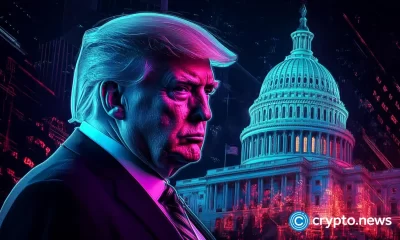

Blockchain Association urges Trump to prioritize crypto during first 100 days


Pi Network Coin Price Surges As Key Deadline Nears


How Viable Are BitVM Based Pegs?
Bankruptcy
The FTX Co-Founder Proved Assistance to the US Authorities
Published
1 week agoon
November 14, 2024By
admin

FTX co-founder Gary Wang, convicted of misusing funds at a fictitious crypto exchange, may face punishment after his case goes to trial.
On Nov. 13, prosecutors in the U.S. District Court for the Southern District of New York filed a brief alleging that Wang provided significant assistance in the investigation of crimes related to FTX, as well as in the prosecution of Sam Bankman-Fried and several other cases.
The government’s attorneys noted the importance of Wang’s testimony at the trial of Bankman-Fried, who was sentenced to 25 years. They also suggested that if Judge Lewis Kaplan decides to sentence Wang, he could develop a tool to identify potential illegal activities in the crypto market. Prosecutors noted that Wang’s testimony was truthful and corroborated by other evidence.
“Wang has also provided substantial assistance – and in the process taken steps to right past wrongs – by putting his extraordinary computer programing skills to use in detecting potential fraud in the stock and cryptocurrency markets.”
Court filing
Wang, who pleaded guilty to wire fraud, commodities fraud, and securities fraud in December 2022, is awaiting final sentencing on Nov. 20.
Is the FTX story nearing its end?
The latest updates would make Wang the fifth and final FTX or Alameda Research executive to face sentencing. Bankman-Fried was the only one to plead not guilty. In contrast, former Alameda CEO Caroline Ellison and FTX Digital Markets co-CEO Ryan Salame pleaded guilty. All of them are currently serving federal prison sentences.
However, the Bankman-Fried case has continued to see new details and court cases emerge, even as the founder of one of the world’s once-largest exchanges is serving his time in prison.
Meanwhile, Bankman-Fried’s assets are under threat
Earlier, U.S. prosecutors filed a lawsuit seeking to seize cryptocurrency, which they say Bankman-Fried used to bribe Chinese officials.
The lawsuit, filed on Nov. 12 in New York District Court, alleges that a Binance account, then worth about $8.6 million but later growing to about $18.5 million, was used to launder money related to bribes before FTX collapsed in late 2022.
Prosecutors noted that in 2021, Chinese authorities froze two Alameda Research accounts on Chinese exchanges that held $1 billion in cryptocurrency. Later, on Nov. 16, 2021, Bankman-Fried was recorded transferring $40 million to a personal wallet, after which the Alameda accounts were unfrozen. Prosecutors allege that Bankman-Fried initiated additional transactions worth tens of millions of dollars in cryptocurrency to complete the bribe.
“As a result of the Investigation, the Government learned that on or about November 16, 2021, at Bankman-Fried’s direction, approximately 40 million USDT (the “Bribe Payment”) was transferred from an Alameda cryptocurrency wallet hosted by FTX.”
Court filing
The account contained five linked deposit accounts, obscuring the origin of the bribe funds. They described a “flood” of deposits and withdrawals from the account and regular transfers of Bitcoin (BTC) and stablecoins to five wallets. Ellison testified that the total amount of bribes was about $150 million.
Bankman-Fried was initially charged with additional charges related to financial fraud and bribery of foreign officials, which were later dropped. On Sept. 13, his defense team filed an appeal, arguing that Bankman-Fried’s trial was unfair.
Meanwhile, the new FTX management is bombarded with lawsuits
FTX’s new management, meanwhile, is once again preparing lawsuits and demanding money. This time from Binance.
FTX bankruptcy trustees have filed a lawsuit against Binance and its former CEO, Changpeng Zhao, demanding a return of about $1.8 billion. The plaintiffs claim that Binance obtained the funds in a fraudulent transaction in 2021.
According to court documents, FTX and its trading subsidiary Alameda Research were probably insolvent from the start and were certainly insolvent on their balance sheets by early 2021. Therefore, the plaintiffs allege that the share buyback deal was fraudulent.
The lawsuit is one of many filed by FTX and Alameda against their former investors, affiliates, and customers as part of the bankruptcy case. On Nov. 9, the companies filed 23 lawsuits. Among them are claims against U.S. exchange Crypto.com and the political group FWD.US founded by Mark Zuckerberg.
FTX has also filed claims against Anthony Scaramucci and his hedge fund, SkyBridge Capital. The exchange’s lawyers claim that in 2022, Bankman-Fried invested $67 million in various SkyBridge projects since Scaramucci was “seeking financial assistance.” However, these investments “brought virtually no benefit,” the plaintiffs say. According to court documents, FTX is now trying to recover more than $100 million in damages from the company.
Alameda has also filed a lawsuit against Sasha Ivanov, the founder of the Waves blockchain. The company intends to return the $90 million invested in Vires Finance. This liquidity platform then operated on Waves.
“To divert attention from his involvement in the fraud, Ivanov attempted to publicly blame Alameda for destabilizing the Waves ecosystem, tweeting that Alameda had manipulated the WAVES price and organized FUD (“Fear, Uncertainty, and Doubt”) campaigns to trigger panic selling.”
Alameda lawsuit
And what’s next?
In general, the history of the FTX and exchange executives are two different stories. While the platform executives serve their sentences, FTX creditors are frantically trying to return the money they wasted.
The debt to creditors is about $11.2 billion, and the funds available to cover the debt is $14.6-16.3 billion.
Thus, there is very little time left before the end of the scandalous exchange story – to decide on punishment for Wang and repay everyone’s debts.
Source link
Bitcoin
Senator to Push the Bill in Trump’s First 100 Days
Published
1 week agoon
November 14, 2024By
admin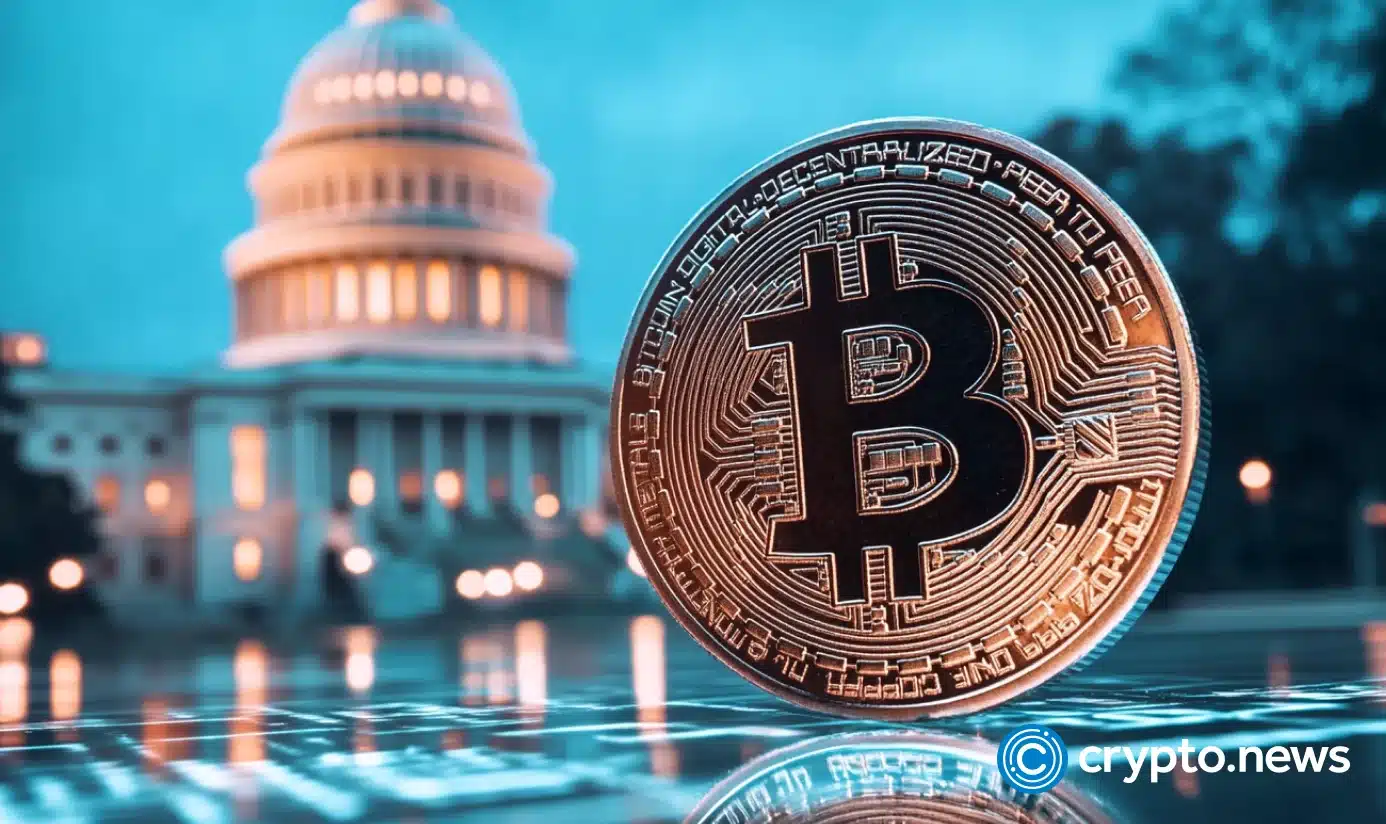
The Senate hopes to push through a Bitcoin reserve bill in the first 100 days of Trump’s presidency while the Republicans consult on crypto policy.
American Senator Cynthia Lummis expressed optimism that plans to create a strategic Bitcoin (BTC) reserve will be implemented soon after Donald Trump‘s inauguration.
“I believe we can get this done with bipartisan support in the first 100 days if we have the support of the people. It is a game changer for the solvency of our nation. Let’s put America on sound financial footing and pass the Bitcoin Act!”
Senator Cynthia Lummis
Lummis’s post responded to David Bailey, BTC Inc. CEO, who has been actively advising Trump on cryptocurrency policy. Bailey had previously suggested that such a reserve could be created quickly under the new administration.
“The Bitcoin and Crypto industry’s policy wishlist is long and pressing… but the Strategic Bitcoin Reserve is the #1 most urgent and transformational policy on President Trump’s agenda. The downstream effects change everything. We must get it done in the first 100 days.”
David Bailey, BTC Inc. CEO
Bailey also floated the idea of using Bitcoin more widely in government programs. He suggested that if Robert F. Kennedy Jr. were appointed Secretary of Health and Human Services and assumed responsibility for managing the Social Security program, there would be a discussion about paying 5-10% of Social Security payments in Bitcoin, stored in a strategic reserve.
What is known about the Bitcoin reserve project?
Trump announced the creation of a Bitcoin reserve in the U.S. in July 2024 during a speech at an event supporting his election campaign. A few days before the politician’s announcement, media reports appeared that Senator Cynthia Lummis was preparing a Bitcoin reserve bill called the BITCOIN Act of 2024.
The act proposes creating a network of decentralized vaults nationwide to securely store Bitcoin reserves. The U.S. Treasury Department is supposed to have 200,000 BTC annually for five years, and the U.S. reserves would eventually amount to one million BTC. It is also assumed that Bitcoin reserves will be stored for at least 20 years.
The cryptocurrency can be purchased at the expense of other assets at the authorities’ disposal, such as gold certificates. Lummis proposes to cover the costs of purchasing cryptocurrency by revaluing it.
In addition, the proposal plans to implement a reserve verification system to verify the availability of funds and consolidate all existing BTC that are currently in the possession of the U.S. government into a new reserve.
Bitcoin reserves to make the U.S. new crypto haven
Analysts at CoinShares write that implementing the plan to create strategic reserves in BTC can generate significant institutional and government interest in Bitcoin. According to their forecasts, this will potentially accelerate its growth and raise its value to new heights.
In general, many participants in the crypto community expect that the U.S. bet on Bitcoin can significantly increase the cryptocurrency’s investment attractiveness. For example, Anthony Pompliano, the founder of Pomp Investments, is confident that the initiative will cause the market to experience FOMO.
Lummis’ proposal implies that the pace of Bitcoin purchases may outpace the cost of BTC mining. In this case, a cryptocurrency deficit will form in the market, which can also support the growth of its rate.
Trump’s rally is in full swing. Or just a rally?
In general, Lummis’ words are confirmed based on the dynamics of Bitcoin and the entire crypto market since the U.S. elections. Over the past week, Bitcoin has repeatedly updated historical highs.
The total capitalization of the entire crypto market has grown by 25% in a week and exceeded $3 trillion. At the same time, the price of Bitcoin has increased by 23.8% in 7 days, several times updating the all-time high and reaching $93,000.
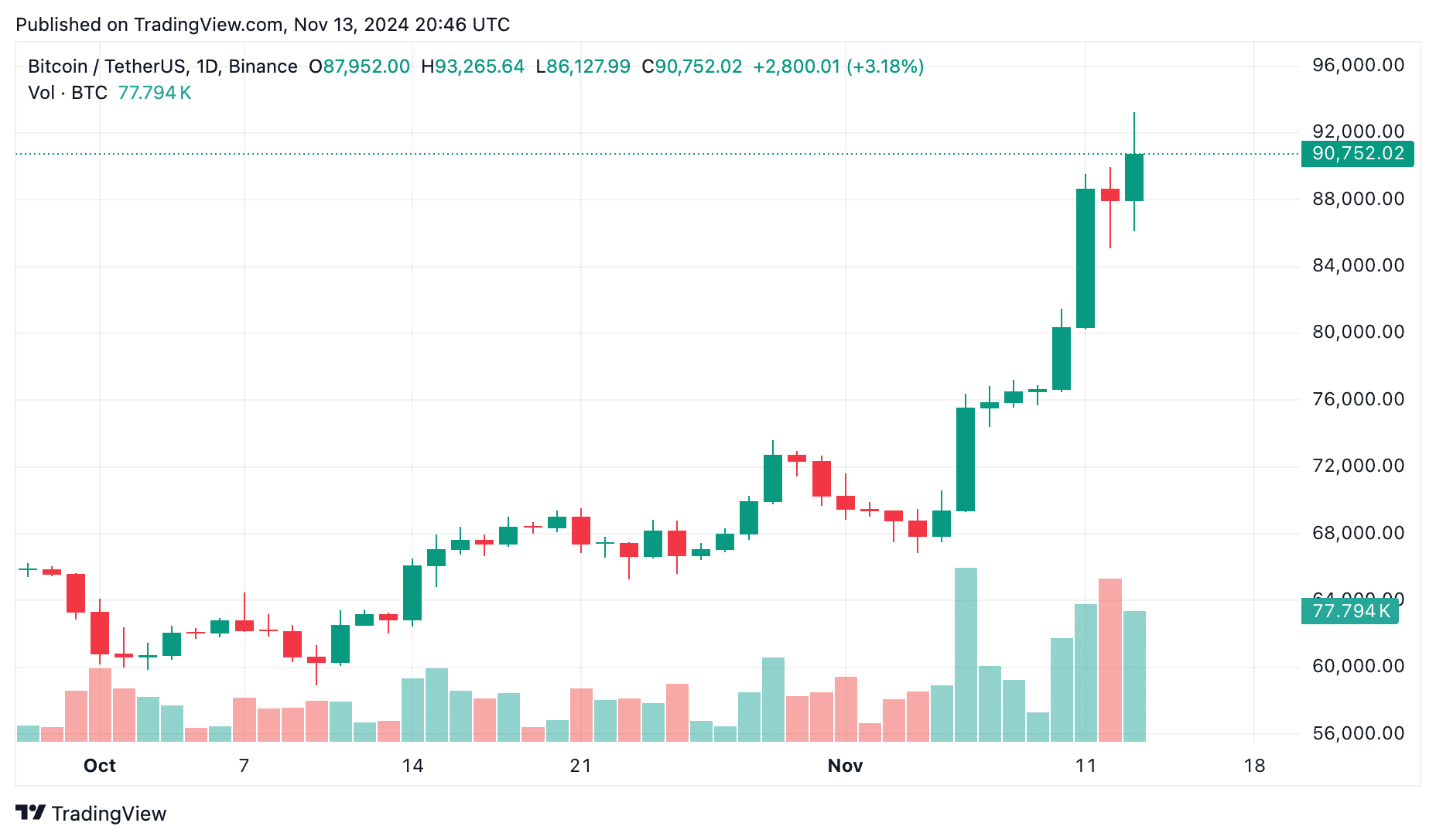
The crypto market’s index of fear and greed has grown by as much as 14 points in a week—from 70 points to 84 out of 100- indicating the market’s extreme greed.
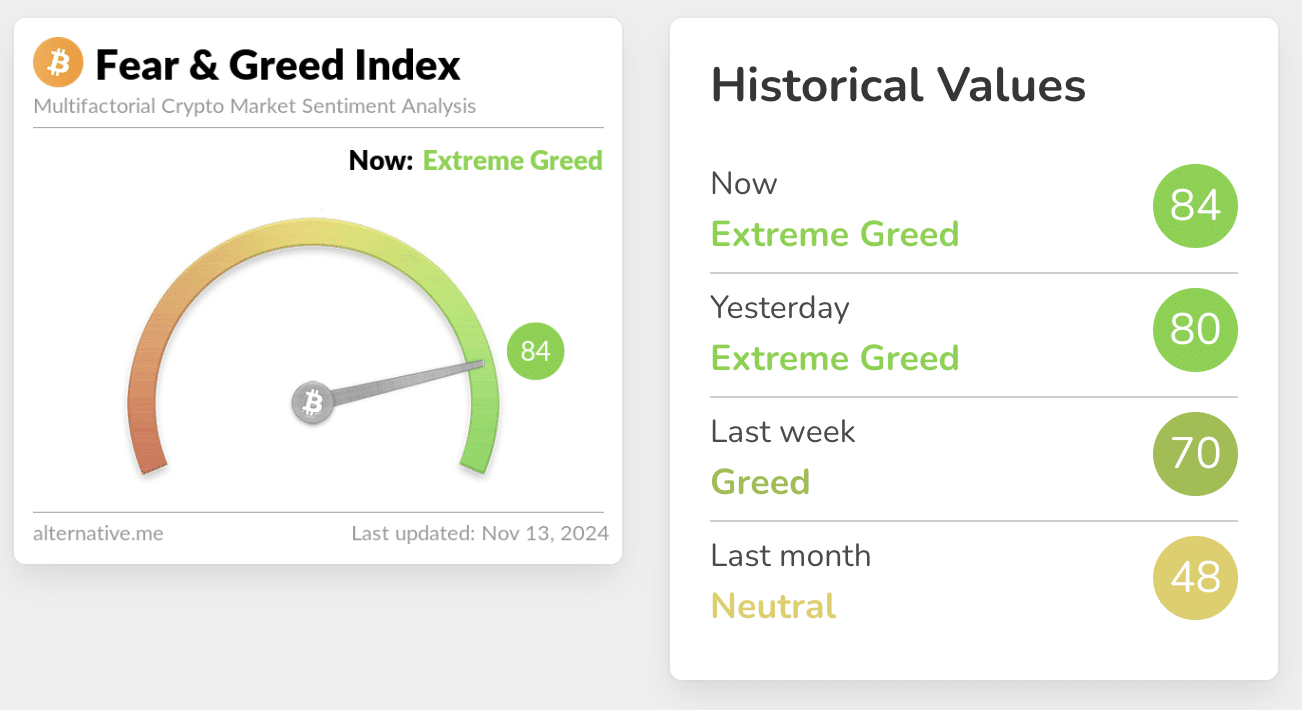
However, some experts doubted that Trump’s victory was the only growth driver of the crypto market.
Thus, the co-founder of Onramp Bitcoin, Jesse Myers, noted that such crypto market dynamics are routine and predictable after the Bitcoin halving in April. During this time, a shortage of coins has arisen on the market, therefore the price is growing under pressure from demand. This triggers a chain reaction that should lead to another bubble.
If you’re wondering what’s happening with #Bitcoin…
Yes, the incoming Bitcoin-friendly administration has provided a recent catalyst…
But, that’s not the main story here.
The main story here is that we are 6+ months post-halving.
And that means a supply shock has… pic.twitter.com/XkwPoPxrj2
— Jesse Myers (Croesus 🔴) (@Croesus_BTC) November 11, 2024
Myers reminded that the same situation happened after each previous Bitcoin halving, so it makes sense to expect something similar this time. The change of power in the U.S. to one potentially more friendly to cryptocurrencies only acted as a catalyst.
Source link
Bankruptcy
Here’s how Bitcoin reserves have changed since FTX collapse
Published
2 weeks agoon
November 10, 2024By
admin
November marks two years since the FTX exchange went bankrupt. Since then, major crypto exchanges have seen their Bitcoin reserves grow.
FTX’s inability to maintain sufficient reserves to meet user requests exposed severe flaws in its controls. It also highlighted the need for greater transparency and reliable reserve reporting among all crypto exchanges.
Observers have grown keenly aware of the risks that exchanges face when they lack sufficient reserves. If they cannot meet withdrawal requests, it undermines user confidence and puts them at risk of losing funds. Maintaining adequate reserves is critical for liquidity and order execution, especially during volatile periods.
In light of this trend, CryptoQuant shared with crypto.news a study on the state of exchange proof-of-reserves (PoR).
How has crypto changed post-FTX?
FTX‘s collapse in November 2022 was one of the most significant and dramatic events in the crypto industry’s history. This incident undermined investor confidence and caused profound changes in the crypto market’s structure and functioning.
At the time, the price of Bitcoin (BTC) and other major cryptocurrencies fell, reflecting fear and distrust of institutional players in the market. Many investors began to doubt the safety and stability of crypto and, as a result, decided to leave the market completely.
Attention toward security issues became even more urgent. Many crypto exchanges and projects have begun implementing new measures to protect users’ funds, including two-factor authentication, monitoring systems, and analyzing transactions for suspicious activity.
New security standards have emerged, as well as solutions to prevent the loss of funds in case of hacks or fraudulent activities. Among others, the PoR standard has emerged — a mechanism cryptocurrency exchanges use to publicly demonstrate that they have enough assets in reserve to cover all user balances.
“PoR fosters trust and transparency, as it allows users to confirm that an exchange has not over-leveraged or mismanaged their assets, which has become particularly crucial following high-profile exchange collapses in the industry.”
CryptoQuant
Major exchanges record Bitcoin outflow
Among the major exchanges with the most prominent Bitcoin reserves, only Coinbase does not publish PoR reports. Experts note that the other major exchanges periodically provide such reports with varying degrees of transparency.
Binance’s reserve increased by 28,000 BTC, or 5%, reaching 611,000, despite the pressure from the U.S. authorities in 2023. Among the major exchanges, Binance also shows the most minor reserve decrease over the entire period, not exceeding 16%.
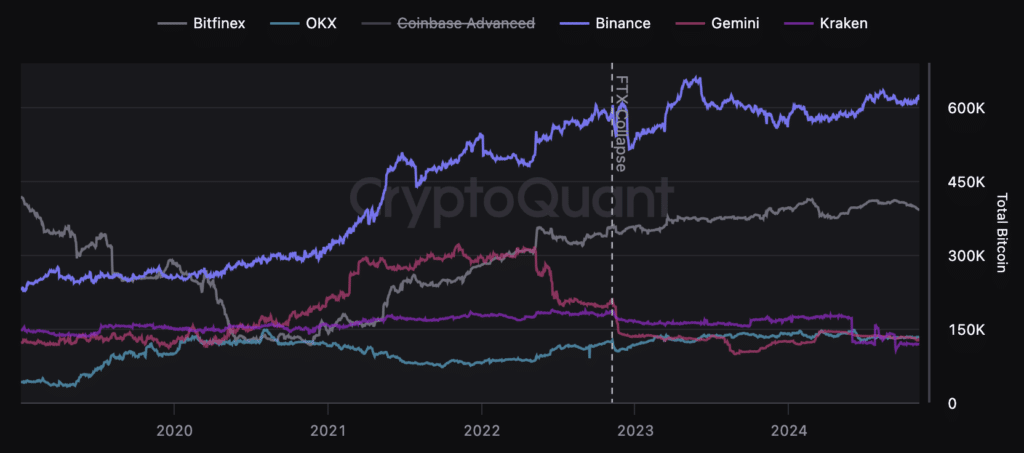
Three key exchanges hold 75% of all Bitcoins held by exchanges. These are Coinbase Advanced, with 830,000 BTC, Binance with 615,000, and Bitfinex, which has 395,000 Bitcoins.
Together, the reserves of these platforms reach 1.836 million BTC, which is 9.3% of the total amount of Bitcoins in circulation. The remaining 17 exchanges hold a total of 684,000 BTC.
Reserves landing
Currently, Binance, Bitfinex, and OKX show small decreases in reserves. At the same time, Binance appears to be the only exchange that has not experienced significant drawdowns in its history.
Analyzing exchange reserves based on tracking their changes allows us to assess their ability to meet user demands over time.
Significant declines may indicate that users are massively withdrawing their funds, indicating a decrease in trust or financial problems.
The most significant decline in Binance’s reserves was 15%, which occurred in December 2022, shortly after the FTX crash. At the time, Binance faced considerable criticism and distrust over its reserve report.
However, Binance’s reserves have recovered and are currently down only 7%. Other significant exchanges have also seen slight declines, with Bitfinex down 5% and OKX down 11%.
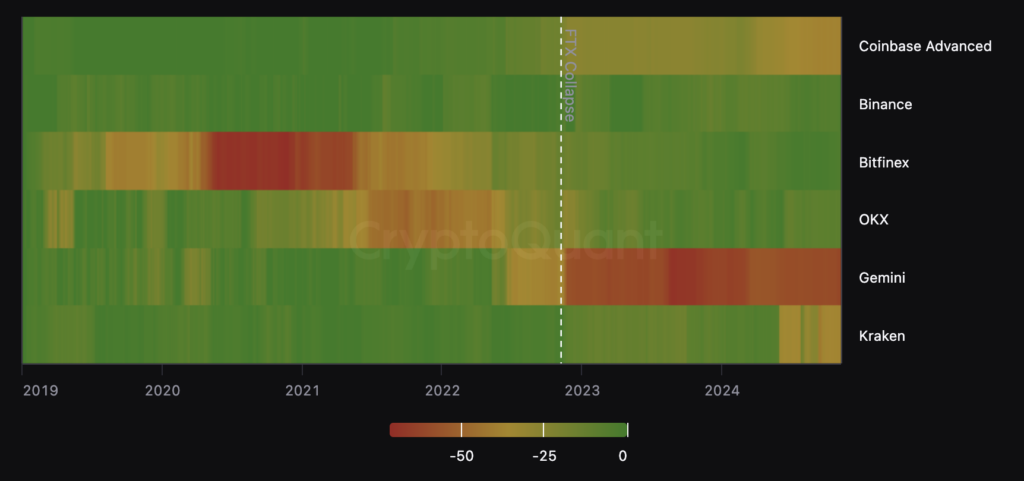
While industry leaders like Binance and Bitfinex have managed to shore up their reserves since the FTX crash, the situation is still tense. The failure of some major players like Coinbase to publish PoR reports suggests that the road to full transparency is still far off. But the current reserve dynamics indicate a desire to improve and increase users’ trust.
The expert, in a comment to crypto.news, emphasized that the bankruptcy of FTX underscored the need for crypto exchanges to prove that they have enough reserves.
“This event led to a shift where users prefer exchanges that show proof of their assets on-chain. This pushed the industry to adopt PoR practices, helping rebuild trust and ensure exchanges can back up their users’ funds.”
Nick Pitto, head of marketing at CryptoQuant
Source link

3 Tokens Ready to 100x After XRP ETF Gets Approval

Gary Gensler’s Departure Is No Triumph For Bitcoin

Magic Eden Token Airdrop Date Set as Pre-Market Value Hits $562 Million

Blockchain Association urges Trump to prioritize crypto during first 100 days

Pi Network Coin Price Surges As Key Deadline Nears

How Viable Are BitVM Based Pegs?

UK Government to Draft a Regulatory Framework for Crypto, Stablecoins, Staking in Early 2025

Bitcoin Cash eyes 18% rally

Rare Shiba Inu Price Patterns Hint SHIB Could Double Soon

The Bitcoin Pi Cycle Top Indicator: How to Accurately Time Market Cycle Peaks
Bitcoin Breakout At $93,257 Barrier Fuels Bullish Optimism

Bitcoin Approaches $100K; Retail Investors Stay Steady

Solana Hits New ATH On Huge Whale Accumulation, More Gains Ahead?

Microsoft Should Buy $78 Billion Worth of Bitcoin

Ethereum Believers May Be Staring Down Opportunity As ETH Reaches Another Low Against Bitcoin: CryptoQuant CEO
182267361726451435

Top Crypto News Headlines of The Week

Why Did Trump Change His Mind on Bitcoin?

New U.S. president must bring clarity to crypto regulation, analyst says

Ethereum, Solana touch key levels as Bitcoin spikes

Bitcoin Open-Source Development Takes The Stage In Nashville

Will XRP Price Defend $0.5 Support If SEC Decides to Appeal?

Bitcoin 20% Surge In 3 Weeks Teases Record-Breaking Potential

Ethereum Crash A Buying Opportunity? This Whale Thinks So

Shiba Inu Price Slips 4% as 3500% Burn Rate Surge Fails to Halt Correction

‘Hamster Kombat’ Airdrop Delayed as Pre-Market Trading for Telegram Game Expands

Washington financial watchdog warns of scam involving fake crypto ‘professors’

Citigroup Executive Steps Down To Explore Crypto
Mostbet Güvenilir Mi – Casino Bonus 2024

Bitcoin flashes indicator that often precedes higher prices: CryptoQuant
Trending

 2 months ago
2 months ago182267361726451435

 24/7 Cryptocurrency News3 months ago
24/7 Cryptocurrency News3 months agoTop Crypto News Headlines of The Week

 Donald Trump4 months ago
Donald Trump4 months agoWhy Did Trump Change His Mind on Bitcoin?

 News3 months ago
News3 months agoNew U.S. president must bring clarity to crypto regulation, analyst says

 Bitcoin4 months ago
Bitcoin4 months agoEthereum, Solana touch key levels as Bitcoin spikes

 Opinion4 months ago
Opinion4 months agoBitcoin Open-Source Development Takes The Stage In Nashville

 Price analysis3 months ago
Price analysis3 months agoWill XRP Price Defend $0.5 Support If SEC Decides to Appeal?

 Bitcoin4 months ago
Bitcoin4 months agoBitcoin 20% Surge In 3 Weeks Teases Record-Breaking Potential


